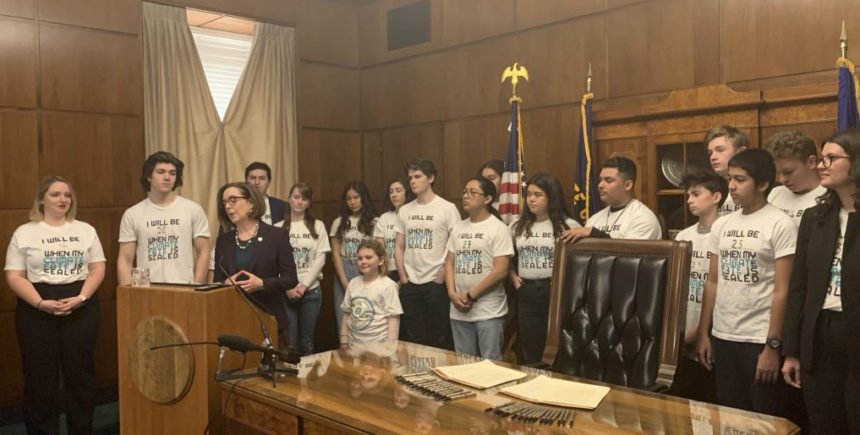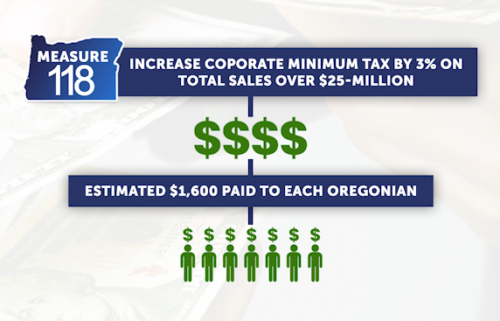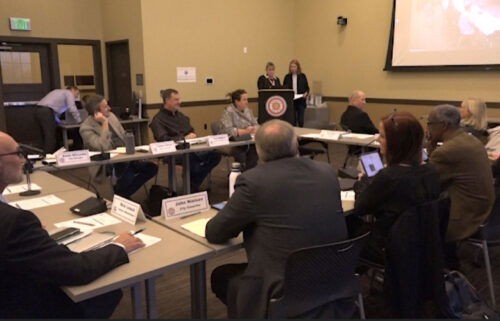Gov. Brown takes sweeping action to cut global warming

GOP lawmaker: 'All this is going to do is initiate a whole bunch of lawsuits'
SALEM, Ore. (AP) — In an end run around Republican legislators, Oregon’s Democratic governor ordered the state on Tuesday to lower greenhouse gas emissions, directing a state agency to set and enforce caps on pollution from industry and transportation fuels.
Gov. Kate Brown’s sweeping executive order, one of the boldest in the nation, aims to reduce carbon emissions to at least 45% below 1990 levels by 2035 and an 80% reduction from 1990 levels by 2050. It more than doubles a clean fuels program, making it the most ambitious goal for clean fuels in the country, Brown said at a news conference.
“I’ve heard it loud and clear from our young people in Oregon: climate action is crucial and urgent,” Brown said, surrounded by students. “If we adults don’t take action right away, it is the next generation that will pay the price.”
Republican lawmakers, a minority in the Legislature, staged a walkout during this year’s short session to sabotage a bill that aimed at many of the same climate goals. The boycott caused the session to end two days early on Friday, with only three bills passed and more than 100 dying, including the climate measure.
Senate Republican leader Herman Baertschiger, Jr. predicted Brown’s executive action would wind up in court.
“I think all this is going to do is initiate a whole bunch of lawsuits,” he said Monday. Brown’s legal team said it is confident they would prevail in any litigation.
The order beefs up Oregon’s clean fuels program. It is currently on schedule to achieve a 10% reduction in the carbon intensity of fuels — primarily gasoline and diesel — by 2025, said Kristen Sheeran, director of Brown’s carbon policy office. The governor’s executive order doubles the target to a 20% reduction by 2030, and 25% by 2035, Sheeran said.
In Oregon, the state has regulatory authority under existing law, Sheeran said. Brown’s executive order directs the Department of Environmental Quality to create additional rules and take additional actions to meet the goals.
“In the absence of effective federal engagement on these issues, it is the responsibility of individual states to take immediate action,” the order says.
“This action will hold large corporate polluters accountable for the pollution they create,” said Tera Hurst, executive director of Renew Oregon, a group that advocates for clean energy.
___
Follow Andrew Selsky on Twitter at https://twitter.com/andrewselsky
--
News release from Gov. Kate Brown:
Governor Kate Brown Takes Climate Action
New executive order outlines state-level steps to combat the effects of climate change
(Salem, OR) — Governor Kate Brown today announced and signed a new executive order on climate, setting new science-based greenhouse gas emissions goals and directing state agencies to put new measures into effect to lower the state's greenhouse gas emissions to meet Oregon's climate goals.
"I’ve heard it loud and clear from our young people in Oregon: climate action is crucial and urgent. If we adults don’t take action right away, it is the next generation that will pay the price. We owe it to them to do our part to ensure that the globe they inherit is on a better trajectory than the one it’s on today," said Governor Brown. "Immediate and comprehensive efforts are needed to tackle this scourge that is devastating the Oregon we know and love, and a smart approach can both protect the environment and grow our economy.
"This executive order is extensive and thorough, taking the boldest actions available to lower greenhouse gas emissions under current state laws. As a state, we will pursue every option available under existing law to combat the effects of climate change and put Oregon on a path we can be proud to leave behind for our children."
The executive order updates the existing state carbon emissions goals to reflect the current science, setting a standard of 45% reduction from 1990 levels by 2035, and an 80% reduction from 1990 levels by 2050. The order also outlines a variety of means to reach the new goals, including:
- Sector-specific caps on climate pollution: Directs the Environmental Quality Commission to set and enforce sector-specific caps on climate pollution for three of the largest sources of emissions in our state: transportation fuels, natural gas, and large industrial polluters. Caps will decline over time in order to meet the state's greenhouse gas reduction goals.
- Doubles the Clean Fuels Program: To reduce climate pollution from cars and trucks by 20% by 2030, and 25% by 2035, the state will more than double the Clean Fuels Program. This is the most ambitious goal for clean fuels in the country, and it will substantially reduce carbon emissions in the transportation sector, using a model proven to reduce pollution at a very minimal cost. At the same time, it will create new jobs in the biofuels sector and expand investment in transportation electrification.
- Higher energy efficiency for buildings and appliances: Directs the state’s building codes division to move rapidly to increase energy efficiency requirements for new buildings and directs the Oregon Department of Energy to make Oregon’s appliance efficiency standards equal to the most stringent in the country.
- Strategic plan to accelerate usability of electric vehicles: Directs the Oregon Department of Transportation (ODOT) to create a statewide public electric charging plan to accelerate the usage of electric vehicles across the state.
- Emissions-conscious transportation spending: Directs ODOT to develop a tool to evaluate all future transportation spending, including road expansion, through the lens of reducing greenhouse gas emissions, and requires regional transportation planning organizations in the state to follow suit.
- Accelerates the transition to clean energy resource in the utility sector: Directs the Public Utility Commission (PUC) to help utilities achieve the new emission reduction goals, and directs the PUC to implement the recommendations of the Governor's Council on Wildfire Response to safeguard our grid from the growing risks and severity of wildfires.
- Adds climate action as a top priority for agency decision making: Directs state agencies to add climate action as a lens for all of their work, which will lower carbon emissions across current agency activities, including as agencies spend the state's budget on goods and services.
The full executive order is available here, and Governor Brown's remarks are available here.
--
SALEM, Ore. – Oregon House Speaker Tina Kotek (D-Portland) issued the following statement today in support of Governor Kate Brown signing an executive order to take climate action:
“I applaud Governor Kate Brown for protecting our planet and our children’s future by taking bold action today with her executive order to combat climate change. Her order puts Oregon on a path to reduce our greenhouse gas pollution according to strong, science-based targets. I will be reviewing the executive order to see whether we need to take additional climate action in our upcoming special session.”
--
SALEM, Ore. – House Majority Leader Barbara Smith Warner (D-Portland) issued the following statement on Gov. Kate Brown’s climate action executive order:
“After years of obstruction by Republicans and the corporate pollution lobby, today is the day we say no more and take action for future generations. Too many Oregon communities are facing the direct impacts of climate change right now. While we still have more work to do, this is a historic and positive path forward. I want to thank Gov. Brown for her steadfast leadership in ensuring Oregon is doing its part to address climate change.”
--
SALEM, Ore. -- House Republican Leader Christine Drazan (R-Canby) released the following statement on Governor Kate Brown’s Executive Order No. 20-04.
“I am not surprised that the governor has moved to overextend her authority to advance a flawed vision of leadership that exposes our state to litigation. This is not only an abuse of power, it shows how out of touch the governor is with the pressing needs of families and communities across the state. Oregon struggles to protect foster kids, improve graduation rates and address homelessness, but rather than acknowledge the need for greater leadership in these essential areas the governor misdirects time and attention away from core functions and our shared priorities to double down on climate at any cost.”
--
Salem, Ore. - Partnership for Oregon Communities, a coalition of farmers, employers, unions and community leaders from across the state, released the following statement regarding Governor Brown’s executive order on carbon regulation:
“Governor Brown’s executive order on carbon is based on questionable legal authority, and will undoubtedly face significant legal challenges. The effort to implement an expansive program without legislative approval is problematic on many fronts and sets a concerning precedent for how our state government will operate in the future. Rather than accepting compromises that were proposed over the last two years, her administration has unfortunately decided to move forward on a path that will put taxpayers on the hook for significant litigation costs, with outcomes that are far from certain. A similar effort in Washington state resulted in years of costly litigation, with limited results.
“The substance of the executive order itself is concerning in a number of respects. First, it hands over unprecedented levels of power to unelected bureaucrats who will have the authority to regulate virtually every sector of our state’s economy, including manufacturing, gasoline and diesel costs and basic utilities like natural gas. Second, due to the nature of rulemaking, the Governor will have few options for blunting the most negative impacts of her order. At the end of the day, her directive could lead to a cap-and-trade style program that is far more sweeping than any proposal contemplated by the Legislature in recent years and will inevitably lead to significant cost increases for consumers and businesses alike, while offering little in the way of meaningful environmental benefits.”
--
The following is a statement from Oregon League of Conservation Voters Executive Director Doug Moore regarding Governor Kate Brown's executive order to tackle climate change.
“Today, Governor Kate Brown delivered for Oregonians, especially younger Oregonians, with an historic executive order to tackle climate change. Oregon can now stand proud as a leader on the most important issue of our time.
This is what climate leadership looks like: cleaner fuels that reduce toxic air pollution and improve the health of Oregonians, cleaner buildings that are more energy efficient and save people money on energy bills, big polluters truly held accountable, and meeting our critical climate reduction goals so that the next generation and the next after that get a chance to thrive.
This executive order means hope for our kids’ future, and it shows the power of real leadership backed up by an incredible movement of people – people from across our state, from young to old, from different backgrounds and with different life experiences – all fighting together and never giving up on achieving climate action.”



